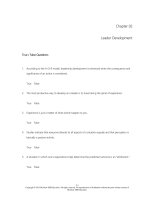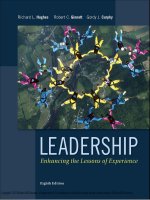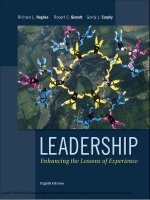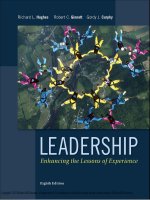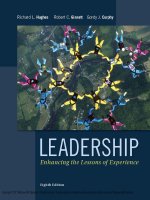Leadership enhancing the lessons of experience 8th by hughes curphy chap 02
Bạn đang xem bản rút gọn của tài liệu. Xem và tải ngay bản đầy đủ của tài liệu tại đây (570.78 KB, 31 trang )
Copyright © 2015 McGraw-Hill Education. All rights reserved. No reproduction or distribution without the prior written consent of McGraw-Hill Education.
2-1
Chapter
2
Leader Development
“Leadership and learning are indispensable
to each other.”
~John F. Kennedy
2-2
Action-Observation-Reflection Model
• Making the most of experience is key to
developing one’s leadership ability.
• The action-observation-reflection (A-O-R)
model shows that leadership development is
enhanced when the experience involves three
different processes:
– Action
– Observation
– Reflection
• Spiral of experience: Colin Powell’s
example.
2-3
The Spiral of Experience
2-4
Key Role of Perception in the
Spiral of Experience
• Experience is not just a matter of what events
happen to you; it depends on how you perceive
those events.
• Perception affects all three phases of the
action-observation-reflection model.
• People actively shape and construct their
experiences.
2-5
Perception and Observation
• Observation and perception both deal with
attending to events around us.
– We are selective in what we attend to and what we, in
turn, perceive.
• Perceptual sets can influence any of our senses:
– They are the tendency or bias to perceive one thing and
not another.
– Feelings, needs, prior experiences, and expectations can
all trigger a perceptual set.
• Stereotypes represent powerful impediments to
learning.
– Awareness of biases occurs upon reflection.
2-6
Perception and Reflection
• Reflection deals with how we interpret our
observations.
• Perception is inherently an interpretive, or a
meaning-making, activity.
• Attributions are the explanations we develop for
the behaviors or actions we attend to.
• Fundamental attribution error is the tendency to
overestimate the dispositional causes of behavior
and underestimate the environmental causes
when others fail.
2-7
Perception and Reflection (continued)
• A self-serving bias is the tendency to make
external attributions for one’s own failures, yet
make internal attributions for one’s successes.
• The actor/observer difference refers to the
fact that people who are observing an action
are much more likely than the actor to make the
fundamental attribution error.
• Reflection involves higher functions like
evaluation and judgment, not just perception
and attribution.
2-8
Perception and Action
• Research shows that perceptions and biases
affect supervisors’ actions towards poorly
performing subordinates.
• The self-fulfilling prophecy occurs when our
expectations/predictions play a causal role in
bringing about the events we predict.
• Studies show that having expectations about
others can subtly influence our actions, and
these actions can, in turn, affect the way others
behave.
2-9
Role of Expectations in
Social Interaction
2-10
Reflection & Leadership Development
• Reflection offers leaders insights about framing
problems differently, viewing situations from
multiple perspectives, and understanding
subordinates better.
• Leaders tend to ignore reflection due to a lack of
time or a lack of awareness of its value.
• Intentional reflection may prompt leaders to see
potential benefits in experience not initially
considered relevant.
2-11
Single- and Double-Loop Learning
• Single-loop learners seek relatively little feedback
that may significantly confront their fundamental
ideas or actions.
– Individuals learn only about subjects within the “comfort
zone” of their belief systems.
• Double-loop learning involves being willing to
confront one’s own views and inviting others to do
the same.
– Mastering double-loop learning can be thought of as
learning how to learn.
– Learning is enhanced with after event reviews (AERs).
2-12
Making the Most of Your Leadership
Experiences: Learning to Learn from
Experience
• The learning events and developmental
experiences that punctuate one’s life are usually
stressful.
• Being able to go against the grain of one’s
personal historical success requires a strong
commitment to learning and a willingness to let
go of the fear of failure.
• To be successful, learning must continue
throughout life and beyond the completion of
one’s formal education.
2-13
Leader Development in College
• The number of college-level leadership studies
programs is rising, but few programs offer
academic credit, such as academic minors.
• Leadership programs should be
multidisciplinary and should cultivate values
through service learning.
• Program elements might involve individualized
feedback to students.
• Case studies, role playing, simulations, and
games provide opportunities for self-discovery
and practice.
2-14
Leader Development in
Organizational Settings
• Organization-based leadership programs benefit
both the individual and the organization.
• The return on investment (ROI) for investments
in leadership development are both positive and
substantial.
• Most programs are aimed at leaders and
supervisors in industry and public service.
• Program content depends on the organization
level of participants:
– First-level supervisors
– Mid-level managers
2-15
Leader Development in
Organizational Settings (continued)
• Programs for first-level supervisors use lectures,
case studies, and role-playing exercises to
improve supervisory skills:
– Training
– Monitoring
– Giving feedback
– Completing performance reviews
2-16
Leader Development in
Organizational Settings (continued)
• Mid-level manager programs use individualized
feedback, case studies, presentations, role
playing, simulations, and in-basket exercises to
improve the following:
– Interpersonal skills
– Oral and written communication skills
– Time management skills
– Planning
– Goal setting
2-17
Leader Development in
Organizational Settings (continued)
• Conger states that a multi-tiered approach is
effective and should focus on personal growth,
skill building, feedback, and conceptual
awareness.
• Leadership development in the 21st century must
occur in more lifelike situations and contexts.
• Leadership programs for senior executives and
CEOs focus on strategic planning, public
relations, and interpersonal skills.
2-18
Action Learning
• Traditional training programs involve personnel
taking leadership classes during work hours.
• Such training addresses common leadership
issues, but its artificial nature makes it difficult to
transfer concepts to actual work situations.
• In contrast, action learning involves the use of
actual work issues and challenges as the
developmental activity itself.
• The philosophy of action learning is that the best
learning involves learning by doing.
2-19
Development Planning
• Development planning is a process that helps
leaders to accelerate the development of their
own leadership skills.
• To make enduring behavioral changes, leaders
must provide positive answers to five questions:
– Do leaders know which of their behaviors need to
change?
– Is the leader motivated to change these behaviors?
– Do leaders have plans in place for changing targeted
behaviors?
– Do leaders have opportunities to practice new skills?
– Are leaders held accountable for changing targeted
behaviors?
2-20
Development Planning (continued)
• Development planning is more than a plan—it is
really a process.
• Good development plans are constantly being
revised as new skills are learned or new
opportunities to develop skills become available.
• Development planning provides a methodology
for leaders to improve their behavior even as
they go about their daily work activities.
2-21
Coaching
• Coaching is a key leadership skill that can help
leaders improve the bench strength of the group
and retain high-quality followers.
• Coaching is the “process of equipping people
with the tools, knowledge, and opportunities they
need to develop and become more successful.”
• There are two types of coaching: informal and
formal.
2-22
Coaching (continued)
• Informal coaching takes place whenever a
leader helps followers to change their
behaviors.
• According to Peterson and Hicks, the best
informal coaching generally consists of five
steps:
–
–
–
–
–
Forging a partnership
Inspiring commitment
Growing skills
Promoting persistence
Shaping the environment
2-23
Coaching (continued)
• The 5-step informal coaching process can be
used to diagnose why behavioral change is not
occurring and what can be done about it.
• Informal coaching can and does occur anywhere
in the organization.
• Informal coaching is effective for both highperforming and low-performing followers.
• Coaching increases in difficulty when it occurs
either remotely or across cultures.
2-24
Coaching (continued)
• Formal coaching programs are designed for
the specific needs and goals of individual
executives and managers in leadership
positions.
• Such programs share common features:
– The one-on-one relationship between manager and
coach lasts from six months to more than a year.
– The process begins with an assessment of the
manager to clarify development needs.
– The coach and manager meet monthly to build skills.
– Role plays and videotape are used extensively, and
coaches provide immediate feedback.
2-25
